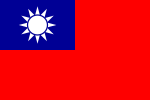
Back Taipei-traktaten Danish Sino-Japanischer Friedensvertrag German Traité de Taipei French Perjanjian Taipei ID 日本国と中華民国との間の平和条約 Japanese 중일화평조약 Korean Tratado de Taipei Portuguese สนธิสัญญากรุงไทเป Thai Hòa ước Trung-Nhật Vietnamese 中日和約 Chinese
The Sino-Japanese Peace Treaty (Chinese: 中日和平條約; Japanese: 日華平和条約), formally the Treaty of Peace between the Republic of China and Japan[1] (Chinese: 中華民國與日本國間和平條約; Japanese: 日本国と中華民国との間の平和条約) and commonly known as the Treaty of Taipei (Chinese: 台北和約), was a peace treaty between Japan and the Republic of China (ROC) signed in Taipei, Taiwan on 28 April 1952, and took effect on August 5 the same year, marking the formal end of the Second Sino-Japanese War (1937–1945).
Neither the Republic of China nor the People's Republic of China was invited to sign the San Francisco Peace Treaty due to disagreements by other countries as to which government was the legitimate government of China during and after the Chinese Civil War. Under pressure from the United States, Japan signed a separate peace treaty with the Republic of China to bring the war between the two states to a formal end with a victory for the ROC. Although the ROC itself was not a participant in the San Francisco Peace Conference due to the resumption of the Chinese Civil War after 1945, this treaty largely corresponds to that of San Francisco in respect to the issue of Taiwan. In 1972, Japan unilaterally terminated this treaty after it established diplomatic relations with the PRC government.
- ^ "Treaty of Peace between the Republic of China and Japan". United Nations Treaty Series. 1952. Retrieved 21 April 2020.
© MMXXIII Rich X Search. We shall prevail. All rights reserved. Rich X Search

